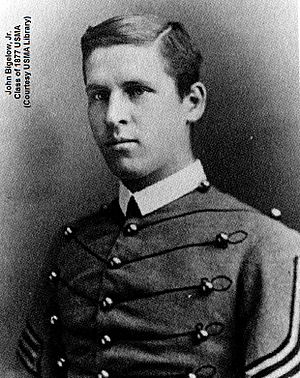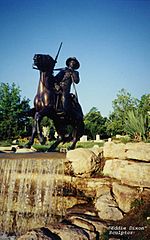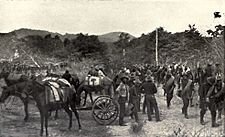John Bigelow Jr. facts for kids
Quick facts for kids
John Bigelow Jr.
|
|
|---|---|

John Bigelow Jr. USMA Class of 1877
|
|
| Born | May 12, 1854 New York City, New York |
| Died | February 29, 1936 (aged 81) Washington, District of Columbia |
| Allegiance | |
| Service/ |
|
| Years of service | 1877–1904 & 1917–1919 |
| Rank | Lieutenant colonel |
| Battles/wars | Indian Wars Spanish–American War World War I |
| Relations | John Bigelow (father) Poultney Bigelow (brother) |
| Other work | Teacher and writer |
John Bigelow Jr. (born May 12, 1854 – died 1936) was an important officer in the United States Army. He reached the rank of lieutenant colonel. He was known for his writings about military life on the American frontier. These stories appeared in Outing Magazine, which was run by his brother, Poultney Bigelow. The famous artist Frederic Remington drew pictures for these articles.
Bigelow's own journals about his time with the Buffalo Soldiers were later turned into a book called Frontier Cavalryman. He earned a Silver Star and a Purple Heart for his brave actions in Cuba during the Spanish–American War. After retiring from the Army in 1904, he became a teacher at the Massachusetts Institute of Technology (MIT) and wrote several books. He was called back to serve in the Army during World War I and retired again in 1919. He passed away in 1936 at the age of 81.
Contents
Early Life and Family
John Bigelow Jr. was born in New York City, New York. His father was a well-known statesman named John Bigelow, Senior. John Jr. spent many of his early years living in France and Germany. Because of this, he learned to speak French very well. He also understood some German and Italian.
In 1883, John Bigelow Jr. married Mary Dallam. They had a son and several daughters. Sadly, only one of their daughters lived longer than him. Their son, Captain Braxton Bigelow, was killed in 1917 while fighting in World War I. He was serving with the British Royal Engineers.
Serving in the Indian Wars
John Bigelow Jr. graduated from the United States Military Academy in 1877. This famous school is located at West Point. He wanted to join the cavalry, which are soldiers who fight on horseback. He was first assigned to the 10th U.S. Cavalry. Later, he also served with the 9th U.S. Cavalry.
While at West Point, Bigelow met Henry Ossian Flipper. Flipper was a classmate who had been born into slavery. Bigelow saw the unfair treatment and racism that Flipper faced. His time growing up in Europe had not prepared him for such hatred. With some quiet help from his friends, Flipper became the first African American to graduate from West Point.
The Buffalo Soldiers

After the American Civil War, two cavalry regiments were formed for African American soldiers. These were the 9th Cavalry and the 10th U.S. Cavalry. These brave soldiers were often called "Buffalo Soldiers" by Native Americans. By 1877, these regiments, led by white officers, were experienced in fighting in the Indian Wars and living on the frontier. Bigelow, who later served with the 10th Cavalry, wrote important historical notes about the Buffalo Soldiers. These notes are still used today.
In December 1877, Bigelow began his duty at Fort Duncan in West Texas. He was part of Company B, 9th Cavalry. He quickly learned how to be a cavalry trooper. His journals and drawings helped create a vivid picture of his time on the frontier.
From 1875 to 1881, the 9th Cavalry was involved in the Apache Wars in New Mexico, Colorado, and Texas. Bigelow took part in the later stages of these wars. This included the Battle of Tularosa in May 1880, where they fought against Chiricahua Apache warriors led by Victorio. In 1881, the 9th Cavalry moved east to Fort Riley, Kansas. Bigelow, however, was transferred to the 10th U.S. Cavalry and moved to Fort Davis in Texas in October 1882.
Serving with the 10th Cavalry
In 1885, the 10th Cavalry moved from Fort Davis to Arizona. During this journey, all 12 troops of the regiment came together for the first and only time in its history. Bigelow described it as an amazing sight. By May 20, 1885, the regiment reached its new main base at Fort Apache, Arizona. Soon after, they were sent to different isolated forts for duty.
In the mid-1880s, the Army was hunting for the famous Apache leader Geronimo. Bigelow and his troop were part of this search, patrolling from Fort Grant. Many patrols were carried out, and the public was very interested in the hunt. Harper's Weekly magazine sent a young artist named Frederic Remington to draw these historic events. Remington met Bigelow, who was a friend of Remington's old Yale classmate, Poultney Bigelow (John's brother). This meeting started a long friendship between John Bigelow and Frederic Remington.
Bigelow let Remington read his journals and see his sketches. Bigelow's journals became the basis for articles about the hunt for Geronimo in his brother's Outing magazine. Remington drew many pictures for the magazine, often including his new friend, John Bigelow. Bigelow, now a seasoned cavalryman, taught Remington a lot about military life on the frontier. Remington's later paintings often showed Bigelow's tall, lean figure.
Although Captain Henry Ware Lawton captured Geronimo in September 1886, the 10th Cavalry played a big part in making it happen. Bigelow and his troop were part of the escort that took Geronimo to the train station for his imprisonment.
In 1891, the 10th Cavalry's headquarters moved to Fort Grant. Bigelow was the Regimental Quartermaster, responsible for supplies. There, he wrote a short history of the 10th Cavalry, which became an important military record.
Later Career and the Spanish–American War

In June 1898, Captain Bigelow, leading D Troop of the 10th Cavalry, landed in Cuba. The tough jungle conditions were very hard on his soldiers. His unit was part of a group that included the 1st Volunteer Cavalry, also known as the Rough Riders, led by Lt. Colonel Theodore Roosevelt. Bigelow's unit was in the middle of the fighting. They fought in three main battles on the way to the city of Santiago de Cuba.
The first battle was the Battle of Las Guasimas on June 24, 1898. Here, Bigelow and the 10th Cavalry helped save some of the Rough Riders. The Rough Riders had been ambushed and were stuck under enemy fire. Frederic Remington, who was there as a war reporter, experienced the true horror of combat during this battle. He later painted "Scream of the Shrapnel" in 1899, showing this event.
The second battle was the Battle of El Caney on July 1. Spanish forces bravely held off the Americans for almost twelve hours. After that came the famous Battle of San Juan Hill later that afternoon.
Bigelow and his troops were under fire from the Spanish defenders on San Juan Heights. Other units were getting into position. But no orders to attack came. Bigelow's second-in-command, First Lieutenant Jules Garesche Ord, asked Brigadier General Hamilton S. Hawkins for permission to attack. Hawkins did not give permission, but he also didn't say no. On his way back, Ord told other units, including Roosevelt's Rough Riders, to support the regular soldiers when they went up the hill.
Captain Bigelow led his soldiers up the steep slopes of San Juan Hill. Even though they were under heavy fire, Bigelow was hit by a bullet but kept urging his men forward. He was then hit by three more Spanish bullets and fell. Soldiers nearby reported that he told them, "Men, don't stop for me, just keep up the charge until you get to the top of the hill." His men continued the attack and helped provide cover for other units.
Sadly, Jules Ord, Bigelow's second-in-command, reached the top but was then shot in the throat and died. On that single day, half of the 10th Cavalry's officers and one-fifth of its soldiers were injured or killed. First Lieutenant John J. Pershing, who was the quartermaster, took over command of D Troop. Pershing had also helped lead the charge up Kettle Hill.
Bigelow received the Silver Star for his bravery at San Juan Hill. He also received a Purple Heart for his four wounds. He spent many months recovering from his injuries. In 1899, he returned to Cuba to investigate Spanish war claims.
Teaching at MIT
From 1894 to 1898, Bigelow was a professor of Military Science and Tactics at the Massachusetts Institute of Technology (MIT). He taught about military strategy and history.
Bigelow used the Chancellorsville campaign from the Civil War in his lessons. He believed it showed many different military challenges. He later published his research in a book called The Campaign of Chancellorsville: A Strategic and Tactical Study in 1910. This book was very detailed and set a high standard for military studies. People said he brought "the highest zeal and intelligence" to his teaching at MIT.
From 1905 to 1910, he returned to MIT. This time, he was a professor of French and led the Department of Modern Languages.
Superintendent of Yosemite National Park
After his time in Cuba, Bigelow was moved to different forts across the United States. In 1904, he became the superintendent of Yosemite National Park. This job was often given to officers nearing retirement. At Yosemite, he once again served with parts of the 9th Cavalry Buffalo Soldiers.
In early 1904, Bigelow ordered the creation of an arboretum in Yosemite. An arboretum is like a garden where different types of trees and plants are grown and studied. This arboretum had paths and benches, and plants were labeled in both English and Latin. This was an early effort to help visitors understand the plants in Yosemite. The National Park Service considers Yosemite's arboretum to be the first museum in a national park. Bigelow stated it was "To provide a great museum of nature for the general public free of cost."
Bigelow and his Buffalo Soldiers were some of the first "Park Rangers." They protected the national parks from illegal grazing by animals, poaching (illegal hunting), timber thieves, and forest fires.
Bigelow felt that his strong support for the Buffalo Soldiers made some people in power dislike him. He also saw that the boundaries of Yosemite were being shrunk in 1905 due to pressure from developers. Claiming poor health, he retired from the army in September 1904. He then moved back east to focus on writing and teaching.
Retirement and Later Years
Even after retiring from the Army, John Bigelow Jr. continued to work. He taught French and led the Modern Languages Department at MIT from 1905 to 1910. After that, he spent his time studying military strategy, tactics, and international relations. He wrote several books on these topics.
When World War I began in Europe in 1914, Bigelow wanted to serve his country again. He was called back to active duty as a lieutenant colonel. He served in the War Department's Historical Branch until 1919.
In 1917, Bigelow and his wife suffered a great loss. Their only son, Braxton, was killed while fighting with the British in France. Braxton had joined the British Royal Engineers in 1915 and had earned many awards for his service.
After the war, Bigelow and his wife traveled to Europe with their daughter Jane. They visited their son's grave. Bigelow was discouraged by what he saw in Europe and returned home. He passed away on February 29, 1936, at his home in Washington, D.C., as war was once again threatening Europe.
Honors and Awards
During his military career, John Bigelow Jr. received the Silver Star for his brave actions during the attack on San Juan Hill in Cuba. He also received a Purple Heart because he was wounded four times in that battle.
Military Promotions
| Lieutenant colonel | Major | Captain | First Lieutenant | 2nd lieutenant |
|---|---|---|---|---|
| O-5 | O-4 | O-3 | O-2 | O-1 |
 |
 |
 |
|
|
| 1918 | about 1900 | about 1895 | about 1884 | 1877 |





